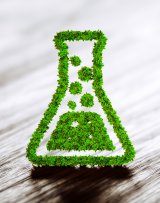TRI in the Classroom: Understanding Pollution Prevention
Pollution prevention (P2), also known as “source reduction,” is any action that prevents or reduces the creation of pollution.
Making everyday products like smart phones, food, and clothing can use or create toxic chemicals. The facilities that make these products must report how much of each chemical is released into the environment. They report this information to the EPA’s Toxics Release Inventory (TRI), and anyone can look it up online. The TRI Program also collects information about what facilities do to keep chemicals from getting into the environment in the first place. The methods they use are known as “pollution prevention (P2),” also known as “source reduction.”
Producing less pollution has many benefits. Less pollution means less waste to control, treat, or dispose of. This can save companies money and keep their workers safer. Less pollution is also better for the health of people who live and work near the facility.
Source Reduction Categories
Each year on their TRI reporting forms, facilities tell EPA about their P2 efforts by choosing from a list of activities organized into five categories.
Material Substitutions and Modifications
Changing one or more materials used in a process so that it creates less pollution or is less harmful to health or the environment. An example is replacing a material that has lead in it with one that has less lead, or no lead at all.
Product Modifications
Changing something about the product being made to reduce the amount of waste created or how harmful the waste is. An example is changing the product size or shape to create less scrap containing toxic chemicals.
Process and Equipment Modifications
Changing the processes or equipment used at a facility to create less waste, or using chemicals that are less hazardous. An example is replacing a cutting machine with a new machine that cuts materials in a better way and produces fewer scraps that have chemicals in them.
Inventory and Material Management
Managing supplies and handling materials to prevent spills, leaks, and wasted materials. An example is looking for finished products that do not meet the facility’s requirements and reworking them into new products instead of disposing of them.
Operating Practices and Training
Improving the everyday or behind-the-scenes processes at a facility to create less waste. Examples include training workers, monitoring, scheduling, and other activities that keep the facility clean and orderly.
Green Chemistry and Green Engineering
Nearly half of the source reduction activities in the list above relate to green chemistry or green engineering. The principles and goals of green chemistry and green engineering are very similar, so the TRI Program groups these activities together.

| Green Chemistry | Green Engineering |
|---|---|
| Designing chemicals and processes to use and create safer materials while also preventing the creation of waste. | Designing products and processes to reduce pollution, use energy and water efficiently, and minimize risk to human health and the environment. |
Some examples of green chemistry and engineering are:
- Replacing a chemical known to cause cancer with one that does not.
- Improving how something is done so that fewer materials or less energy is used.
- Changing the design of a final product to create less scrap waste.
Using TRI's P2 Data
The P2 data found in the TRI can be used to answer questions such as:
- Have chemical releases at a particular facility gone up or down over time?
- Did this change happen because the facility used P2 methods? Or because they changed how much product they made?
- How are other facilities like this one managing the same chemical? What P2 methods have they reported?
- Which P2 practices have led to the biggest decreases in releases of TRI chemicals into the environment?
EPA’s TRI Program shares the P2 information it collects on the TRI website to encourage other companies to start using P2 methods.
Additional Teacher Resources
- TRI and Pollution Prevention webpage
- EPA's Safer Choice Program
- Green Chemistry for the K-12 Classroom (State of Washington Dept. of Ecology)
- 'Beyond Benign' Green Chemistry Curriculum for K-12 (Beyond Benign)
- Clean & Green: Teacher's Guide (American Chemical Society)
